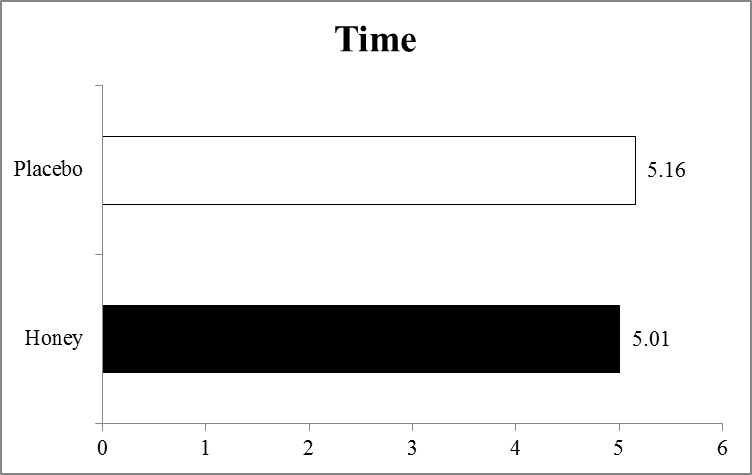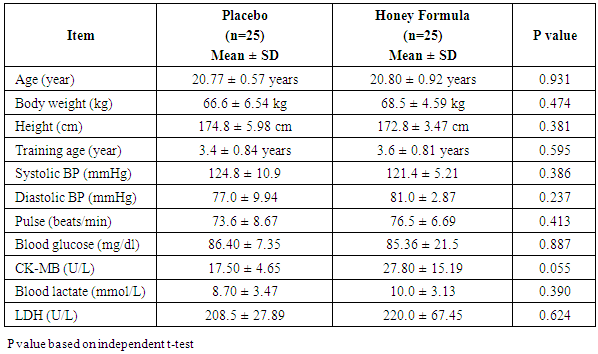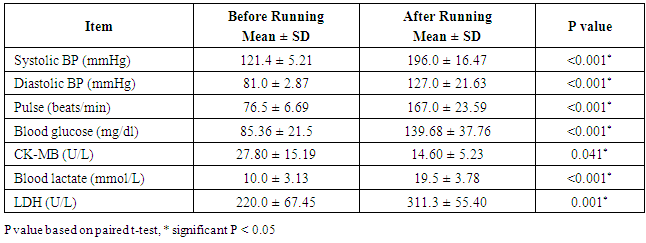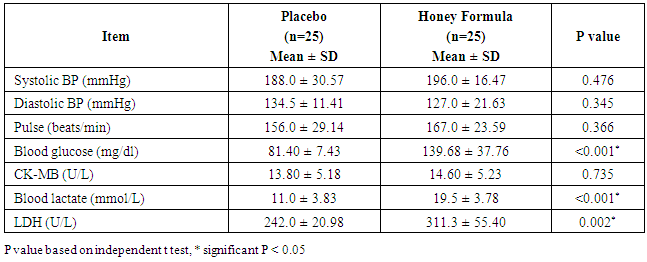-
Paper Information
- Paper Submission
-
Journal Information
- About This Journal
- Editorial Board
- Current Issue
- Archive
- Author Guidelines
- Contact Us
International Journal of Sports Science
p-ISSN: 2169-8759 e-ISSN: 2169-8791
2019; 9(3): 47-53
doi:10.5923/j.sports.20190903.01

The Effect of Honey Supplementation Formula on Delaying Some Fatigue Markers on 1500 Meters Runners with No Impact on Performance
Maged Ossama Aly1, Radwan Elgohary2, Dalia I. Tayel1
1Nutrition Department, High Institute of Public Health, Alexandria University, Egypt
2Biological Sciences and Sports Health Department, Faculty of Physical Education for Boys, Alexandria University, Egypt
Correspondence to: Maged Ossama Aly, Nutrition Department, High Institute of Public Health, Alexandria University, Egypt.
| Email: |  |
Copyright © 2019 The Author(s). Published by Scientific & Academic Publishing.
This work is licensed under the Creative Commons Attribution International License (CC BY).
http://creativecommons.org/licenses/by/4.0/

Background: Honey, royal jelly, and bee-pollen are promoted as nutraceuticals that have numerous nutritional and therapeutic properties with a capability of endurance athletic performance enhancement. Objective: The study aimed to evaluate the effect of honey supplementation formula on runners’ performance and fatigue parameters. Subjects: Fifty male runners, members of the Egyptian Athletic Federation (EAF), were recruited to perform two study groups; one with intervention with the honey drink for one week before and after running and the second group was running without using the honey drink (placebo). Systolic and diastolic blood pressures, pulse rate, blood glucose, blood lactic acid concentration, creatine kinase-muscle/brain (CK-MB), and Lactate dehydrogenase (LDH) were measured before and after running. Results: No significant baseline intergroup differences were observed while there were significant changes were detected in both groups in all parameters investigated according to the pre-and post-exercise intragroup comparison. Blood lactic acid concentration was higher among the honey group than the placebo (19.50 ± 3.78 vs 11.0 ± 3.83 mmol/L, respectively) as well as LDH (311.30 ± 55.40 vs 242.0 ± 20.98 U/L, respectively). However, it can be explained by the insignificant faster race finishing time of the honey group than the placebo group (5.01 ± 0.24 vs 5.16 ± 0.11 minutes, respectively, (p = 0.221). The blood glucose was enormously higher among the athletes who ingested honey than who took placebo only (139.68 ± 37.76 vs 81.40 ± 7.43 mg/dl, respectively). While, there was no statistical difference in the blood pressure, either systolic or diastolic, and CK-MB between both groups. Conclusions: Acute ingestion of honey drink mixed with royal jelly and bee-pollen before running is ergogenic and plays a beneficial role in enhancing running performance.
Keywords: Endurance, Sport, Nutrition, Ergogenic, Supplements, Honey, Egypt
Cite this paper: Maged Ossama Aly, Radwan Elgohary, Dalia I. Tayel, The Effect of Honey Supplementation Formula on Delaying Some Fatigue Markers on 1500 Meters Runners with No Impact on Performance, International Journal of Sports Science, Vol. 9 No. 3, 2019, pp. 47-53. doi: 10.5923/j.sports.20190903.01.
Article Outline
1. Introduction
- Honey was a crucial staple in Ancient Egypt which has been comparatively propelled in the fields of mathematics, medicine, architecture, and astronomy. A medical Ebers Papyrus record has been reported to hold 147 honey recipes 1550 years before Christ. Honey was consumed by Ancient Egyptians not only as a sweetener but also as a medication. There are many countries that are famous for beekeeping, on the top of this list, Egypt, Spain, and Greece. Recently, Egypt has a greater number of honeybee colonies than that in both Spain and Greece. Consequently, approximately 110 tons of different types of honey are annually produced in Egypt and the vast majority is clover, thyme, citrus, and cotton honey types. [1]It is conceivable to state that nowadays, natural dietary formulas are likewise successful to promote wellbeing status and prevent some disorders in addition to performance enhancement. [2] Individuals with sedentary lifestyle satisfy their psychological and physical necessities with everyday nutrition. This circumstance is different in competitors in light of the fact that the higher the physical activity is, the more requirements are needed to fulfil. Consequently, aside from the talent and training preparation, numerous ergogenic substances have seemed to help athletes and improve physical execution. There are several kinds of ergogenic tools including pharmacological, mechanical, physiological, mental, and dietary forms. It is undebatable that some types of these dietary supplements can do harm but on the other hand, some of them are natural foods. [3]Honey is a carbohydrate source containing flavonoid compounds that act as antioxidants and may have ergogenic advantages. [4,5] Numerous researchers have revealed the pharmacological properties of honey such as boosting immunity, may help to prevent peptic ulcers, having an antihypertensive effect, antibacterial, antitumor, anti-fungal, and anti-inflammatory activities. [6-15] the most largely and ordinarily accessible in U.S. markets is clover honey and by and it generally has a fructose-to-glucose proportion near 1.0 making its composition similar to most sports drinks in the market. Therefore, honey is an attractive option for athletes seeking a natural alternative to other commercially produced sports beverages. [16,17] Prolonged workout is often associated with fatigue and reduced performance due to glycogen depletion. [18] So, the studies encouraged the intake of carbohydrate containing beverages, as a bolus feeding or in divided doses manner, to prevent dehydration and overcome glucose depletion to enhance the performance. [19-21] To date, the possible role of carbohydrate contained in honey before exercise is still unclear. Thus, the present study was proposed. Honey used in the present study was obtained from the GAWAD’s Apiaries. Based on the laboratory analysis, it was reported that honey contains 17.7% of water, 40.5% of fructose, 34% of glucose, 1.7% of Dextrin, and 1.5% of sucrose, it also contains 3.4% of amino acids and 82 g of CHO per 100 g of serving. Jentjens and Jeukendrup studied the effect of consuming a mixture of glucose, sucrose and fructose in one study and a mixture of glucose and fructose in another study compared with glucose ingestion alone during prolonged cycling exercise. In both studies, they found that ingestion of a mixture of different types of carbohydrates resulted in higher exogenous carbohydrate oxidation rates. [22,23] The fact that honey consists of multiple transportable carbohydrate and being non-carbonated beverage makes it a perfect fluid to be ingested before exercise leading to higher rates of carbohydrate oxidation, less gastric discomfort, and eventually better athletic performance. [23,24]On one hand, fructose ingestion may have some health consequences such as hypertension, hypertriglyceridemia, and development on insulin resistance. On the other hand, fructose which comes from natural sources such as honey may produce beneficial effects on human health. [25]Royal jelly is an ingredients rich nutrient which composed of sugar, proteins, lipids, vitamins, and other bioactive substances. It is released from the hypopharyngeal and mandibular glands of the worker bees for growth of young larvae and it is considered the main food of the queen bee and nowadays used in variety of food products and supplements. [26]Another special well balanced functional food is the Bee-pollen with valuable health benefits. [27,28] However its use as a nutritional supplement is still controversial because some researchers found that it had positive effects on body functions [29], for muscular endurance and strength [30], and maximum oxygen consumption (VO2 max) of adolescent swimmers. [31] In contrast, there have also been studies that did not support the effects of bee-pollen on exercise. [32]We therefore hypothesized that feeding of multiple transportable carbohydrate source 30 min before exercise would result in delayed fatigue and improved 1500 meters running capacity compared with placebo. In this study, it was aimed at whether there is a beneficial outcome of honey supplementation formula on runners’ performance and fatigue parameters.
2. Participants and Methods
- Fifty male runners, members of the Egyptian Athletic Federation (EAF), were recruited as subjects in this study and their height and body weight were measured. They were healthy with no chronic diseases, especially diabetes, or taking any medication, and have no honey intolerance or Bee-pollen allergy. Subjects were asked to refrain from ingesting any products containing honey for 48 hours before the experimental trials. Subjects were also asked to refrain from strenuous exercise for 24 hours prior to the actual experimental trials. A food diary form was given to each subject to record their food intake three days before the experimental trial. They were required to repeat the same diet over three days before the consecutive experimental trial to minimize differences in muscle glycogen. Subjects were also asked to fast from 10.00 p.m. onwards on the day before the experimental trial. However, they were permitted to drink plain water. Verbal and written consents for approval to participate in the study, giving blood samples, and drinking the honey formula, were obtained from the runners.Preliminary Test:After subjects’ recruitment, the subjects were required to perform a preliminary running test one week before the actual experimental trial in order to familiarize subjects with the experimental protocol, in which they were required to run in the tracking field of the physical education faculty, Alexandria University for 1500 m, obtaining the measurements from them (systolic and diastolic blood pressures and pulse rate) before and after the trial, providing the athletes with an illustration of blood sampling technique and markers that will be analyzed, and the timing and nature of the study beverage that will be ingested.Experimental Trials and Honey supplement:After subjects’ recruitment, the subjects were required to perform two study tests, i.e. with and without intervention with the honey drink, with one week period in between the trials.On the first actual experimental trial day, systolic and diastolic blood pressures and pulse rate were measured during rest then blood samples were drawn via venipuncture by a certified medical laboratory technician to be analyzed for blood glucose, blood lactic acid concentration, creatine kinase-muscle/brain (CK-MB), Lactate dehydrogenase (LDH). Afterward, all subjects performed 1500 running trial and at the end of the race, the time of each athlete was written down and immediately, his blood pressure and pulse were measured. After 7 minutes of finishing, the blood samples were obtained for the chemical analysis.One week later, the same athletes were recruited to do the second experimental trial in the same track and the same weather conditions. The pre-running measurements were done and the study honey formula, that was determined as 50 g of honey + 0.5 g of royal jelly + 0.5 g bee-pollen, was given 30 minutes before running. The same physiological parameters were measured immediately at the finish point and the blood samples were taken 7 minutes after that.Statistical analysis:Statistical analysis was performed using statistical software contained in the Statistical Package for Social Sciences (SPSS) version 23.0. In the present study, time trial running performance was analyzed using the paired t-test. Statistical significance was accepted at P < 0.05. Results are expressed as means ± standard deviation (SD).
3. Results
- No significant baseline intergroup differences were observed in age, body weight, height, training age, systolic and diastolic blood pressures, pulse, blood glucose, CK-MB, blood lactate, and LDH (Table 1).
|
|
|
|
|
 | Figure 1. Running Time for both Placebo and Honey groups |
4. Discussion
- To our knowledge, our study is the first to assess the efficacy of honey drink consumption before exercise as the rest of the literature discussed the result of its ingestion during or post-exercise. The majority of researchers studied the ergogenic beneficial effects of carbohydrate ingestion either in the few hours or minutes or during prolonged endurance athletic performance (more than 45 minutes). [33-35] As a result, it has been limited focus on carbohydrate feeding before short duration, high-intensity exercise bouts (<10 min), because it is well-known that this kind of activity will not deplete muscle glycogen stores to the level that would deteriorate the performance. [36] Current guidelines state that there is no need for ingestion of carbohydrate before events lasting less than 45 min. Consequently, protocols for fuelling for longer than 60 min activities were the main concern. [37] Therefore, more research was needed to define the effects of carbohydrate feeding before short-duration high-intensity exercise.The notable finding of the present study is that ingestion of honey drink before 1500 m running trial could not significantly improve running performance compared to plain water (5.01 vs 5.16 minutes, respectively, p = 0.221). However, the significantly higher values of plasma glucose, lactic acid, and LDH of the subjects in the honey group during the running trial could be attributed to the maintenance of blood glucose level during running caused by the presence of CHO contained in honey drink compared to plain water.The blood lactic acid concentration was higher among the honey group than the placebo as well as LDH. However, it can be explained by the non-significant slightly faster race finishing time of the honey group than the placebo group which can be attributed to the fact that honey drink contains a number of antioxidants from a variety of sources which have been associated with improving vasodilation and conditions associated with inflammatory response. [38]Febbraio and colleagues found that when blood glucose level is elevated before exercise tasks, the rate of glucose uptake and carbohydrate oxidation by the contracting skeletal muscles are accelerated in the early phase of the event. [39,40] Another study, focused on the effects of timing of intake and carbohydrate concentration of pre-exercise carbohydrate feeding on short duration high intensity athletic performance, reported that exercise capacity was similar on all 0g, 11.5g and 68.8g of carbohydrate before each exercise trial. [36]The studies on the metabolic changes of pre-exercise carbohydrate feeding on prolonged endurance activities have reported that these metabolic effects only remain evident during the first 10-15 min of prolonged exercise when carbohydrate is ingested 15-30 min before exercise, and are often not evident at all if carbohydrate is ingested 75-120 min before exercise. [41-43] Rowlands and Houltham provided an evidence of a small benefit of multiple transportable (2:1 maltodextrin/glucose-fructose) compared with single-transportable carbohydrate ingested to long-distance triathlon performance (half-ironman competition). [44] A study done by Earnest, the participants ingested honey gel, dextrose, or a placebo before long distance cycling time trial. There was a rising trend of power (in Watt) at the end of the trial among the honey group. [4]The beneficial effect of carbohydrate feeding to improve performance during prolonged exercise sessions is arguable. Some studies reported a valuable improvement [45-47] while others didn’t support that. [48-51] Abbey, et al. 2009 studied effect of ingesting a Honey-sweetened beverage on soccer performance and concluded that acute ingestion of honey containing beverages with its antioxidant properties and a carbohydrate sports drink before and at frequencies typical of a regular football match did not improve performance for trained players. [48] Another investigation done by Ali and his colleagues who assessed the effect of Ingestion of a carbohydrate-electrolyte solution during exercise enabled healthy male University soccer players with depleted glycogen stores to better maintain skill and sprint performance than when ingesting fluid alone. [45]
5. Conclusions
- Ingestion of Honey supplementation formula 30 minutes before 1500 meters running trial was not ergogenic as it is expected that the CHO present in honey would play a role for enhancing running performance in the present study. It is possible that increasing the frequency of carbohydrate consumption would have improved performance; however, this is not practical for most players in the real scenario. Until additional research on the dosage and timing of honey consumption before high intensity short duration events is conducted, our results indicate that honey, royal jelly, and Bee-pollen in general, may be beneficial for delaying some fatigue markers but not for 1500 meters running performance. In addition, the comparison between a honey drink with another drink containing carbohydrate in their effects on sports performance is proposed to be carried out as our future study.
ACKNOWLEDGEMENTS
- The study was designed by Maged Ossama Aly, Radwan Elgohary, Dalia I Tayel; data were collected and analyzed by Radwan Elgohary; and data interpretation and manuscript preparation were undertaken by Maged Ossama Aly and Dalia I Tayel. All authors approved the final version of the paper.Special thanks to all the athletes and coaches who cooperated with me and contributed their time and effort to complete this work.
 Abstract
Abstract Reference
Reference Full-Text PDF
Full-Text PDF Full-text HTML
Full-text HTML



